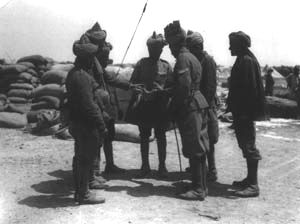Gallipoli
 14th Sikhs of the 29th Indian Infantry Brigade examining a piece of shell from 'Asiatic Anne'. © Imperial War Museum
14th Sikhs of the 29th Indian Infantry Brigade examining a piece of shell from 'Asiatic Anne'. © Imperial War Museum
The narrow strait of the Dardanelles separated the heavily fortified Gallipoli peninsula from the mainland coast of Turkey. This slip of a sea passage, only one mile wide at its narrowest point, allowed ships to travel between the Mediterranean Sea and the Black Sea. When Turkey declared war against the Allies on 29 October 1914 the Dardanelles passage was closed to Allied shipping, and sea communications with the Allies' co-combatant Russia were cut off. Formidable shore batteries of heavy guns and eleven belts of mines were sited to protect the Dardanelles narrows.
The vast cornfields of the Ukraine were a highly important Allied asset, and in 1915 the British First Lord of the Admiralty, Winston Churchill, lobbied hard for a landing at Gallipoli to capture the peninsula and open the strait once more. On 25 April came the first assault. Australians and New Zealanders (Anzacs) landed at Ari Burnu halfway up the peninsula, intending to capture the heights of Chunuk Bair, but they were repulsed and penned into a narrow area near the landing beaches. The British came ashore at Cape Helles on the southern tip of Gallipoli: they almost reached their objective, the as-yet unoccupied hill of Achi Baba, but the Turks just beat them to it. On 1 May, six days after the initial landings and following terrible losses among the vainly attacking Allied forces, the 29th Indian Infantry Brigade landed. This brigade was composed of units that included the 14th Sikhs, and three Gurkha battalions – 1/5, 1/6 and 2/10.
Allies and Turks dug themselves in and became enmeshed in a replica of trench warfare on the Western Front – brave, futile attacks on heavily defended positions, with large scale losses from both battle and disease. There was a new landing and a breakout from the Anzacs' beachhead in August, which involved a desperate attempt to take the heights of Chunuk Bair; the 29th Indian Infantry Brigade took part in this attack, but was bloodily repulsed along with the other Allied forces. A vicious, attritional stalemate again developed. Though reinforced by fresh Antipodean, French and British troops, the Allies could not effect a breakthrough. Nor could the Turks, from their side, drive the invaders into the sea.
As a freezing winter set in the Allies decided to withdraw from Gallipoli – something that they achieved in a famous piece of trickery as 35,000 soldiers melted away during the night of 8-9 January 1916 and were evacuated under the very noses of the unsuspecting Turks without the loss of a single man.
Militarily Gallipoli was a bloody failure. It cost the Allies and the Turks a quarter of a million men each. But many Australians and New Zealanders consider it the crucible in which their young countries first forged a sense of national identity.
The vast cornfields of the Ukraine were a highly important Allied asset, and in 1915 the British First Lord of the Admiralty, Winston Churchill, lobbied hard for a landing at Gallipoli to capture the peninsula and open the strait once more. On 25 April came the first assault. Australians and New Zealanders (Anzacs) landed at Ari Burnu halfway up the peninsula, intending to capture the heights of Chunuk Bair, but they were repulsed and penned into a narrow area near the landing beaches. The British came ashore at Cape Helles on the southern tip of Gallipoli: they almost reached their objective, the as-yet unoccupied hill of Achi Baba, but the Turks just beat them to it. On 1 May, six days after the initial landings and following terrible losses among the vainly attacking Allied forces, the 29th Indian Infantry Brigade landed. This brigade was composed of units that included the 14th Sikhs, and three Gurkha battalions – 1/5, 1/6 and 2/10.
Allies and Turks dug themselves in and became enmeshed in a replica of trench warfare on the Western Front – brave, futile attacks on heavily defended positions, with large scale losses from both battle and disease. There was a new landing and a breakout from the Anzacs' beachhead in August, which involved a desperate attempt to take the heights of Chunuk Bair; the 29th Indian Infantry Brigade took part in this attack, but was bloodily repulsed along with the other Allied forces. A vicious, attritional stalemate again developed. Though reinforced by fresh Antipodean, French and British troops, the Allies could not effect a breakthrough. Nor could the Turks, from their side, drive the invaders into the sea.
As a freezing winter set in the Allies decided to withdraw from Gallipoli – something that they achieved in a famous piece of trickery as 35,000 soldiers melted away during the night of 8-9 January 1916 and were evacuated under the very noses of the unsuspecting Turks without the loss of a single man.
Militarily Gallipoli was a bloody failure. It cost the Allies and the Turks a quarter of a million men each. But many Australians and New Zealanders consider it the crucible in which their young countries first forged a sense of national identity.